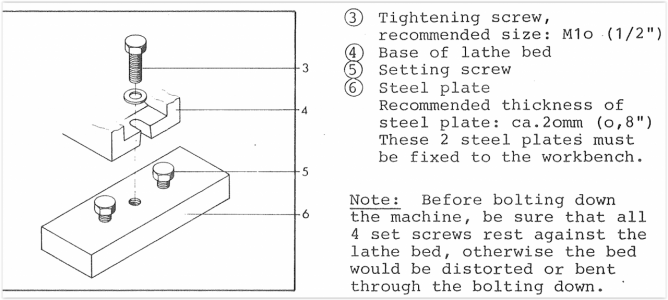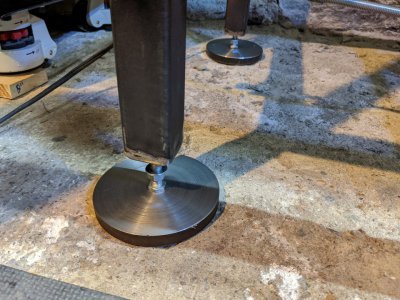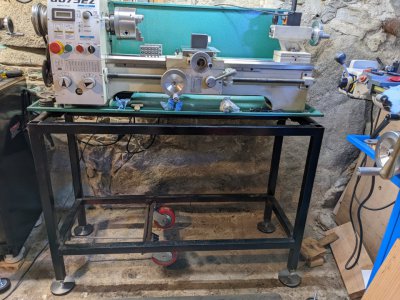TL;DR but I wanted to clarify some stuff:
- I agree you're trying to take the twist out of the lathe BUT the stand has an effect so you need to take care of that first. I suggest you adjust the feet of the stand so it is fairly level along and across the stand. While this is not critical, most precision lathe makers will ask you to do this first when setting up a lathe.
- I suggest you calibrate your level carefully. If it is a precision level then be very careful and very patient to get it dead on. Bubble movements can take from several minutes and up to 15 minutes to truly settle with any changes to adjustment. I am attaching a doc that might help.
- I know the norm is to place your level across the ways; if you do this, make sure the level is precisely at right angles to the ways. I prefer to set the level on the cross slide instead. I remove the compound, clean and stone the cross slide table to make sure it is oil and burr-free and I set the level with a machinist's square so it is aligned with the cross slide bed and about an inch in from the edge (right around where my QCTP would sit). I also place my Starrett 98-6 adjacent to (but not touching) the precision level. The 98-6 is used to get me close and the precision level is used to get me dialed in. From this point on, the levels are not touched until I am done leveling the lathe.
- In order to adjust the level of the lathe (take any twist out), one end has to be locked down and the other end adjusted or twisted until both ends are in the same plane, right? To do this, you must have some mechanism that allows you to adjust each end. That is, there must be a central lock down bolt to lock each end to the stand and adjustment bolts for height adjustment that bear on the front and rear of each foot that is under each end of the lathe. If you lack these adjusters then you are left with shimming the lathe (a major pain) or bolting the lathe down solidly and using the adjusters under the stand. I'm attaching an example that Emco uses for this purpose; works good.
- I suggest loosening the lock down bolt on the tailstock end and then focus on leveling the lathe at the headstock end first. Assuming you will set the level on the cross slide table, move the cross slide up close to the headstock end and use the fore and aft adjusters to get the bubble centered. Remember that it can take several minutes for the bubble to stop moving; be patient. When the headstock end is leveled, lock down the bolt that holds that end to the stand and make sure the bubble didn't move. You can now move to the tailstock end.
- It is likely that the tailstock end will be way off. Tweak the adjusters under the foot and get the bubble centered. It may take some time to do this depending on how much twist there is in the bed. I've worked on lathes that took days to get the twist out. I would get it close and then leave it alone while you go have a beer or a cup of coffee. Come back and see where it is. Adjust again and again until you get it to settle on center, then lock it down. Come back the next day and see where it is and adjust until it stays level. Yeah, lathes can be like that. It took who knows how long for the bed to twist and you are not going to get it to untwist in a few hours so be patient. Eventually, the lathe will settle and the bubble will stay centered. When it does, go back and forth to each end of the lathe to be sure all twist is out of the bed. You may need to make fine adjustments but it should be pretty close at this stage.
- Once the lathe is leveled using your level (you really only need one good level), you are ready for the 2-collar test. The 2 collar test is used to achieve a final level on the lathe. I am not going to tell you how to make the test bar; you can read up on that. I am attaching a doc with details on how the test is done. On my Super 11 lathe, I do not mess with the adjusters under the lathe once I get it leveled with the precision level. I adjust the feet under the cabinet instead and this works well for me. See the doc.
I follow a specific sequence when setting up or checking the alignment of my lathe. I always check my headstock alignment first to make sure the headstock is aligned with the ways. Then I level the lathe as discussed above, followed by a 2 collar test. Then I use a test bar to align the tailstock. When my lathe is adjusted well, it cuts zero taper on a 6-8" bar held in the chuck.
Hope this helps.
EDIT: when doing the 2 collar test, use a sharp HSS turning tool, not carbide. When taking fine cuts of 0.001 - 0.003" deep, you need the tool to cut and not deflect. The nose radius of a carbide insert is not fine enough for this test so use HSS.




